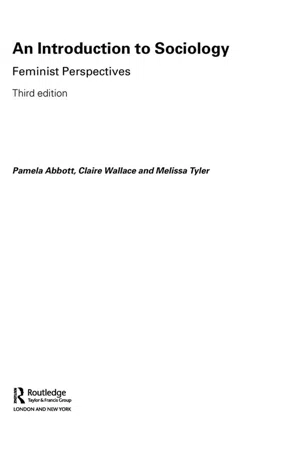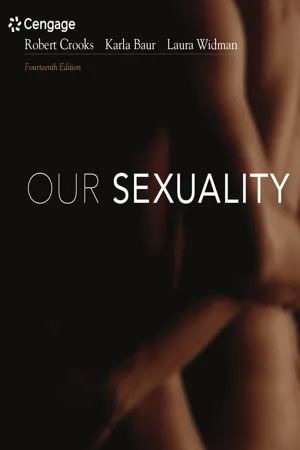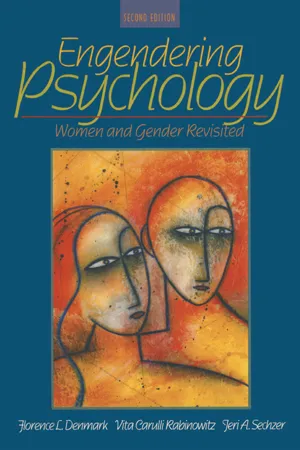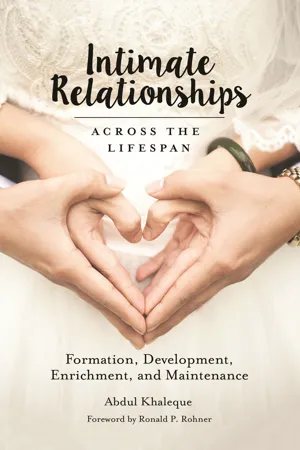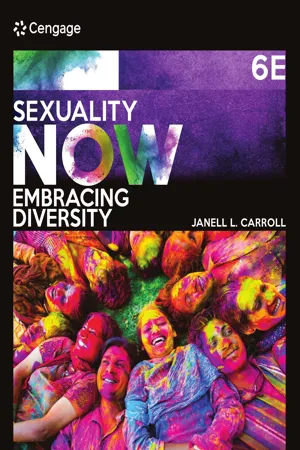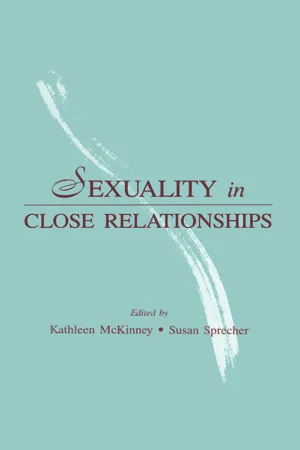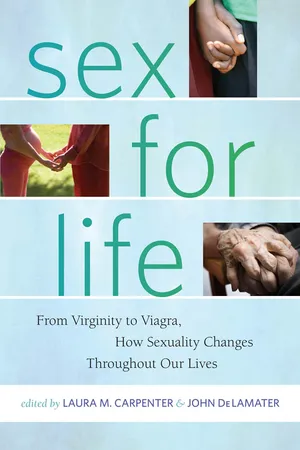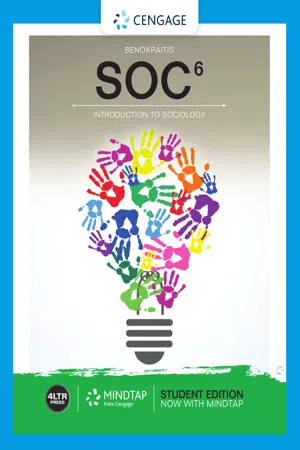Social Sciences
Sexuality in America
"Sexuality in America" refers to the diverse range of sexual attitudes, behaviors, and identities within the United States. It encompasses cultural, social, and political aspects, and has been shaped by historical, religious, and legal influences. The study of sexuality in America involves examining issues such as sexual orientation, gender identity, sexual health, and the impact of societal norms and values.
Written by Perlego with AI-assistance
Related key terms
1 of 5
12 Key excerpts on "Sexuality in America"
- eBook - ePub
An Introduction to Sociology
Feminist Perspectives
- Pamela Abbott, Melissa Tyler, Claire Wallace(Authors)
- 2006(Publication Date)
- Routledge(Publisher)
CHAPTER EIGHTSexuality
Sexuality is generally taken to refer to the social experience and expression of physical bodily desires, real or imagined, by or for others or for oneself. It encompasses erotic desires, identities and practices. Seemingly one of the most private, intimate aspects of our lives, sociologists have argued that sexuality is fundamentally social and political. This is because sexuality is experienced and expressed within relations of power and exchange and what we think of as sexual varies historically and culturally as well as in different social contexts. Sociologists have therefore argued that no human sexual behaviour or practice can be divorced from the social and political circumstances in which it takes place, and the social relations within which it is embedded. This means that even individual sex acts (such as masturbation or other forms of auto-eroticism) are social acts because the way in which we think about and make sense of them is shaped by a range of social values, attitudes, norms and sanctions. Yet sexuality remains something of a neglected topic in sociology when compared to say social class or the mass media, brought onto the sociological agenda only relatively recently. Largely as a result of the contribution of feminist sociologists and political activists sexuality has now begun to emerge as a legitimate focus of sociological concern. Indeed, that New Right movements in many Western societies have mobilised considerable political energies through their emphasis on the sanctity of the family, hostility to gay and lesbian sexuality and to ‘sexual deviance’ of various kinds is, as Jeff Weeks (1991, p. 12) has noted, something of a ‘back-handed compliment to the success of feminism’.Sexuality has been one of the main concerns of feminist theory and politics not least because feminists regard men’s control of women’s sexuality as one of the key mechanisms through which patriarchy is maintained. Feminists have drawn attention to the social control of women’s sexuality through religious, state and medical regulatory practices. In particular, feminists have emphasised the role of sexuality in reinforcing patriarchal power relations, highlighting issues such as pornography, sexual violence, clitoridectomy, prostitution and ‘compulsory heterosexuality’ (Rich, 1980) – the social compulsion to be heterosexual. Feminists have also made a significant contribution to theorising sexuality and the sexual body. They have also highlighted the relative neglect of issues of sexual identity in the social model of disability (Lloyd, 2001). Many have argued that the so-called ‘sexual revolution’ has merely been a means of increasing and legitimating a male right of sexual access to women. Others have highlighted, however, the ways in which sexuality can be a means of challenging and resisting women’s oppression. Feminist contributions have also drawn attention to the ways in which so-called scientific perspectives (including those developed by social scientists) have served to perpetuate women’s sexual oppression. - eBook - PDF
- Robert Crooks, Karla Baur, Laura Widman, , Robert Crooks, Karla Baur, Laura Widman, (Authors)
- 2020(Publication Date)
- Cengage Learning EMEA(Publisher)
Our Sexuality also covers the crucial biological foundations of human sexuality, including the roles of hormones and the nervous system, the biological components of sexual orientation, theories about the role of genetic selection through thousands of years of human evolution, and the impact of specific genetic variables on an individual. The term biopsychosocial describes the integration of these three dimensions (biological, psychological, and social). We may not always be aware of the extent to which our sexual attitudes and behaviors are shaped by society in general and by the particular social and cultural groups to which we belong (Twenge et al., 2015). The subtle ways we learn society’s expectations regarding sexuality often lead us to assume that our behaviors or feelings are biologically innate, or natural. However, an examination of sexuality in other periods of Western history or in other societies (or even in different ethnic, socioeconomic, and age groups within our own society) reveals a broad range of acceptable behavior. What we regard as natural is clearly relative. “Aspects of sexuality that are influenced by culture include values, such as decisions regarding appropriate sexual behaviors, suitable partner or partners, appropriate age of consent, as well as who is to decide what is appropriate. Sociocultural beliefs across the globe influence the answers to each of these questions and in many cases these characteristics are seen as integral to culture” (Heinemann et al., 2016, p. 144). While there is a great diversity of sexual expression throughout the world, all societies have rules regulating the conduct of sexual behavior. “Every soci- ety shapes, structures, and constrains the development and expression of sexu- ality in all of its members” (Beach, 1978, p. 116). Knowledge about the impact of culture and individual experience can make it easier to understand and make decisions about sexuality. - eBook - ePub
Sexuality
A Psychosocial Manifesto
- Katherine Johnson(Author)
- 2015(Publication Date)
- Polity(Publisher)
Despite Helen Merrell Lynd’s warning polarization between psychological and socio-historical approaches has been an all too familiar feature of late twentieth-century thought, particularly in the field of sexuality. In reviewing prominent theories and debates it is reasonable to claim that this polarization constitutes a ‘kind of conceptual impasse’, found in many accounts influenced by either Marx or Freud, or latterly Freud and Foucault, whose vital work sets the scene for contemporary understandings of sexuality within academia and everyday life. This book explores the polarization between psychological and socio-historical accounts that are documented well in sexuality studies and somewhat ambitiously proposes an alternative, a psychosocial manifesto that seeks to stitch and mend the polarization. Yet, as Sedgwick states, trying to remedy, or even articulate the impasse is not without its own problems. Specifically, in trying to articulate accounts of sexuality without recourse to a polarization between psychology and historicism invites us to engage with the ‘psychosocial’, but inevitably within this articulation it is difficult not to fall back on the mechanisms that constitute the split.The term sexuality can refer to a set of practices or behaviours, a range of feelings or affects, or as a way of categorizing people on the basis of their sexual orientation, sexual identity or political allegiances. The plural, sexualities, is utilized to acknowledge the multiple meanings of sexuality and to recognize that an understanding of contemporary sexuality needs to engage with a proliferation of identity categories, sexual practices, subjectivities, desires and relationship formations, including for example queer or trans alongside more familiar categories such as heterosexual, lesbian, gay and bisexual. This book explores the way in which the term is conceptualized in an array of psychological and social debate, such as neuroanatomy, adolescent development, sexual health, youth suicide, identity politics or gay marriage, and provides access to a range of theoretical perspectives that seek to explain how sexuality is developed, constructed, queered, embodied and transformed.Since the late 1800s, sexologists and psychologists have tended to promote the view that sexuality has its origins in biological processes underpinned by hormones, drives, and more recently, genetics. In contrast, historians and sociologists point to the social field as the defining force that shapes the meanings given to sexuality and sexual experience. This observation provides the starting point for investigating how polarization produces different forms of knowledge and the impact these have on how sexuality can be experienced in personal and political contexts. Such distinctions are familiar within social science accounts of sexuality, but they are also apparent within the humanities and queer studies. For example, Michael Warner (1993) expressed a similar warning to Lynd in the seminal text Fear of a Queer Planet - eBook - ePub
Engendering Psychology
Women and Gender Revisited
- Florence Denmark, Vita Carulli Rabinowitz, Jeri A. Sechzer(Authors)
- 2016(Publication Date)
- Psychology Press(Publisher)
It is hard to imagine a topic in which gender matters more than sexuality. Gender surely influences people’s patterns of sexual desire and arousal, their responses to sexual imagery, and their sexual attitudes and practices. As we will see in this chapter, sexual behavior is a response to a complex mix of sociocultural, psychological, and biological forces and cannot be adequately understood in terms of any one force alone.In this chapter, we consider physical aspects of sexuality, research on the nature and extent of various sexual behaviors, sexual orientation, sexual fantasy, responses to sexual imagery, sexuality among those with disabilities, sexual dysfunction, and contraceptive use. But we begin with a discussion of how female sexuality has been socially constructed—how social realities affect how we identify, describe, classify, and ultimately experience sexuality.SEXUALITY IN A SOCIAL CONTEXTWe take a social constructionist perspective on sexuality that focuses on the historical and cultural contexts in which sexuality is learned and practiced. This view suggests that all societies organize sexual desires, behaviors, and identities into approved or encouraged, tolerated, and tabooed patterns (Lorber, 1994). These patterns are internalized by individual members of societies, who often come to view them as natural and inevitable, even biological, in origin.Both female and male sexuality are shaped by society and culture. To be sure, societal messages to males about sex are value laden and conflicting, and may pose many emotional and sexual difficulties for them (Kilmartin, 1994). But in most societies throughout history, sexuality is made problematic for females in ways that it is not for males (Gagnon, 1977; Gagnon & Simon, 1973). Some of these problems are due to the biological fact that sexual intercourse is far more consequential for females than males, because females alone bear children. But others result from the social reality that, throughout history, males have defined sexuality, including female sexuality, from their own perspective. Because of their historically greater physical, social, and economic power, men have been in positions to define when, how, with whom, and under what circumstances sex is appropriate, and they have often done so in ways that are disadvantageous to women. For example, the very definition of what constitutes “having sex” reveals a deeply androcentric (male-centered) and heterosexist bias (see Box 8.1 ). In Western societies, having sex usually refers exclusively to vaginal intercourse, involving male penetration and ejaculation. Hugging, touching, and kissing (which for some women are more stimulating than vaginal intercourse) do not count as having sex in this formulation. If they are considered at all, it is as foreplay - eBook - ePub
Intimate Relationships across the Lifespan
Formation, Development, Enrichment, and Maintenance
- Abdul Khaleque(Author)
- 2018(Publication Date)
- Praeger(Publisher)
CHAPTER ELEVEN Sexuality Sexuality is the key to the problem of the psychoneuroses and of the neuroses in general. No one who disdains the key will ever be able to unlock the door. —Sigmund FreudFreud proposed a pansexual view of human development assuming that sexual urges and pleasures are the primary determinants of all kinds of human behavior, and the resolution of psychosexual conflicts is the key to a healthy life. Few psychologists endorse his views because of his exaggerated importance on the biological aspect of sexuality, ignoring the social and moral aspects of human sexuality. Although many psychologists find it difficult to accept his proposition that any kind of pleasure is related to sex, nobody denies his view that a healthy sexual relationship is an important determinant of a healthy adult intimate relationship and psychological adjustment.Thus sexuality is considered an important component of intimate relationships or close personal relationships. Today there is more openness in expressing sexuality than at any time in the past, especially in Western countries including the United States. Moreover, sexual activity is accepted as a pleasurable, healthy, normal, and positive human behavior. One major change in attitude toward sexuality in Western societies is marked by the greater acceptance of premarital and nonmarital sex in a loving relationship, and more openness, less opposition, and more acceptance of homosexual and bisexual relationships. Another significant change in sexual attitude in Western societies is the decline in the double standard on sex—more sexual freedom for men than women.Sexual Attitudes and BehaviorA survey on sexual attitudes and behavior shows that Americans have different types of views about sexuality. Laumann and Michael (2000), for example, found that about 30 percent of Americans have a traditional or reproductive attitude toward sex. They think that sexual activity should be permissible within the marital relationship for reproductive purposes. Approximately 25 percent of Americans (more men than women) hold a recreational view about sex. This group thinks that sex is for enjoyment, and as long as people enjoy sex and it does not hurt anyone, it should be okay. About 45 percent of Americans have a relational view about sex. They think that sex should be in loving relationships, but not necessarily in the marital relationship only. - eBook - PDF
Homosexuality
Research Implications for Public Policy
- John C. Gonsiorek, James D. Weinrich, John C. Gonsiorek, James D. Weinrich(Authors)
- 1991(Publication Date)
- SAGE Publications, Inc(Publisher)
Regardless of these philosophical debates, most present-day North Americans tend to label themselves homosexual, heterosexual, or bisex-ual despite the fact that these labels do not capture the full range of complexity of sexual orientation and sexual identity. This debate does, however, instruct us that cultural constructs about sexual orientation can have powerful effects on shaping self-concept and identity (for example, Schippers, 1990, p. 6, states: What we are interested in in psychotherapy is the client's interpretation or reconstruction of his or her personal sexual history) as well as scientific discourse (for example Cass, 1983-1984, p. 121, notes that identity as a homosexual can only arise in those societies where homosexual categorization is acknowl-edged). THE POLITICIZATION OF DEFINITIONS OF SEXUAL ORIENTATION The incidence of homosexuality raises problems in measurement that are interesting and important scientific problems. The public discourse on the incidence of homosexuality, however, often takes a more adversarial course. Arguments are sometimes made, for example, that the numbers of gay men and lesbians are swelling, with the implica- 11 Definition and Scope of Sexual Orientation tion that this represents some sort of threat, recruitment, or plot. On the other hand, there are some attempts (e.g., Cameron's work, discussed above) to revise downward the number of gay men with the implication that this especially small group is particularly AIDS-infested or unde-serving of civil rights because of their small numbers. We offer the following perspectives on this issue. First, it is important to note that definitional problems are common in the social sciences. For example, in the 1960s and 1970s there was a vigorous debate between personality and social psychologists about whether personality variables exist at all. - eBook - PDF
Sexuality Now
Embracing Diversity
- Janell Carroll(Author)
- 2018(Publication Date)
- Cengage Learning EMEA(Publisher)
All of these influences impact the social views of sexuality and what behaviors and practices we believe are right and wrong. Feminist Theory Feminist theory argues that society has a strong influence on our ideas about sexuality. Many feminists also believe that sexology in the United States has been dominated by White, middle-class, Sociological Theory Sociologists are interested in how the society in which we live influences sexual behavior. Even though the basic capacity to be sexual might be biologically programmed, how it is expressed var- ies greatly across societies, as we saw in Chapter 1. For instance, there are differences in what societies tolerate, gender roles, and how sexuality is viewed. A behavior that may be seen as normal in one society may be considered abnormal in another. For instance, on the island of Mangaia in the South Pacific, women are very sexually assertive and often initiate sexual activity (D. S. Marshall, 1971). From an early age, elders teach them how to have multiple orgasms. However, in Inis Beag, a remote island off the coast of abstinence The practice of refraining from some, or all, sexual behaviors. sexology The scientific study of sexuality. A person who adopts a biological theory would explain differences in sexuality as resulting from anatomy, hormones, neurochemicals, or other physical explanations. Therefore, a biological theorist would suggest that trouble reaching orgasm would be due to physical reasons, such as hormonal or neurological causes. Treatment might involve a physical workup and blood work to evaluate hormone levels. However, other theoretical approaches would disagree with this assessment and would look at a variety of other issues, such as stress, internal thought processes, or social pressures. Social influences, such as religion, affect our attitudes about various sexual behaviors, including sex outside of marriage, same-sex marriage, contraceptive use, and abortion. - No longer available |Learn more
- (Author)
- 2014(Publication Date)
- Library Press(Publisher)
Doubts have been raised about the validity of this concept in non-Western and indigenous societies, as well as in the pre-modern West. While sexual orientation is reported in this article primarily within biology and psychology, including sexology, for reports within anthropology and history, including social constructionism. Sexual orientation distinguished from sexual identity and behavior Most definitions of sexual orientation include a psychological component, such as the direction of an individual's erotic desire, and/or a behavioral component, which focuses on the sex of the individual's sexual partner/s. Some people prefer simply to follow an individual's self-definition or identity. ________________________ WORLD TECHNOLOGIES ________________________ The American Psychological Association states that sexual orientation is an enduring emotional, romantic, sexual, or affectional attraction toward others. It is easily distin-guished from other components of sexuality including biological sex, gender identity (the psychological sense of being male or female), and the social gender role (adherence to cultural norms for feminine and masculine behavior). Sexual orientation exists along a continuum that ranges from exclusive heterosexuality to exclusive homosexuality and includes various forms of bisexuality. Bisexual persons can experience sexual, emotional, and affectional attraction to both their own sex and the opposite sex. Persons with a homosexual orientation are sometimes referred to as gay (both men and women) or as lesbian (women only). Sexual orientation is different from sexual behavior because it refers to feelings and self-concept. Individuals may or may not express their sexual orientation in their behaviors. - eBook - ePub
- Kathleen McKinney, Susan Sprecher(Authors)
- 2014(Publication Date)
- Psychology Press(Publisher)
And what is sexuality? As in the case of love, most researchers and writers on the topic have avoided definitions. Reiss (1986b) searched 20 human sexuality textbooks and found only 5 contained definitions of their topic, each quite different. Our own search through the literature yielded a similar paucity and a similar range. Some see human sexual behavior and motivation as "not biological but rather social and cultural phenomena" (Kon, 1987, p. 257). Or in Reiss' (1986b) words, sexuality "consists of those scripts shared by a group that are supposed to lead to erotic arousal and in turn to produce genital response" (p. 21). Others adhere to the biological understanding of sexuality as "first and foremost a mechanism by means of which species reproduce themselves" (Beach, 1977, p. 3). More typically, the definition falls somewhere in between, such as that of Strong and DeVault (1988), who described sexual behavior as "characterized by conscious physiological/erotic arousal (such as desire) and that may also be accompanied by physiological arousal ... or activity" (p. G-9).However, the core elements in most definitions seem to be physiological sexual arousal and sexual desire. Thus, we will use the following working definition: Sexuality is the constellation of sensations, emotions, and cognitions that an individual associates with physiological sexual arousal and that generally gives rise to sexual desire and/or behavior . Although this definition is structurally more complex than that of the definition of love, it also emphasizes a motivational element (sexual desire). This definition is also neutral with regard to how sexuality is constructed—biologically, developmentally, culturally, or whatever.A Dimension for Organizing Social Science Approaches to Sexuality and Love
One way to understand the variety of approaches to the relation between sexuality and love is to think of these approaches as lying along a dimension having two extremes—one arguing that love is a mere by-product of sexuality, of the physiological and behavioral reproductive systems dictated by human genes, and the other arguing that sexuality is a mere by-product of the cosmic yearning for love, for fusion, for union (see Fig. 2.1 - eBook - ePub
Sex for Life
From Virginity to Viagra, How Sexuality Changes Throughout Our Lives
- Laura Carpenter, John DeLamater(Authors)
- 2012(Publication Date)
- NYU Press(Publisher)
Introduction Sexualities over the Life Course: The Development of a Perspective JOHN DELAMATER AND LAURA M. CARPENTER How do sexual and social experiences—childhood sex play, immigration, or divorce, for example—at one point in a person’s life affect his or her sexual beliefs and behaviors later on? How are individuals’ sexual biographies shaped by broader cultural and historical changes, such as the sexual “revolution” of the late 1960s and the early 1970s or the increasing availability of same-sex marriage? In what ways do intersections among gender, race, ethnicity, social class, and sexual orientation influence these life course processes, even as life course processes influence those intersecting social statuses in turn? We explore these questions in this book. Introduction As a relatively new area of inquiry, the study of human sexuality from a life course perspective is rapidly coming into its own. This burgeoning field began in earnest in 1994, with the publication of Alice Rossi’s highly regarded edited volume, Sexuality across the Life Course (University of Chicago Press). Since then, scholars of sexuality have greatly expanded the range of topics they study as well as the theoretical approaches they deploy. Although the sexual scripting approach remains ascendant, other perspectives—from biopsychosocial models to Foucauldian genealogies to Bourdieuian fields approaches 1 —are increasingly employed. Life course theory and research have evolved as well, with researchers increasingly replacing models of linear progress—for instance, from education to work to retirement—with perspectives positing multiple and overlapping trajectories, such as work, health, and sexuality, that extend from birth to death - eBook - PDF
- Nijole Benokraitis(Author)
- 2018(Publication Date)
- Cengage Learning EMEA(Publisher)
168 SOC Copyright 2019 Cengage Learning. All Rights Reserved. May not be copied, scanned, or duplicated, in whole or in part. Due to electronic rights, some third party content may be suppressed from the eBook and/or eChapter(s). Editorial review has deemed that any suppressed content does not materially affect the overall learning experience. Cengage Learning reserves the right to remove additional content at any time if subsequent rights restrictions require it. men with similar credentials because women don’t con- sider themselves qualified; (2) they have to do more than their male counterparts to prove themselves; (3) U.S. presidents appoint more men than women to important positions; and (4) there’s a lingering sexism, among both men and women, that female politicians are both less feminine and compassionate than the average woman, and lack the leadership traits associated with male politi- cians (e.g., confident, assertive) (Schneider and Bos, 2014; Parker and Horowitz, 2015; see also Chapter 11). 9-3 SEXUALITY In the movie Annie Hall, a therapist asks two lovers how often they have sex. The man rolls his eyes, and complains, “Hardly ever, maybe three times a week!” The woman exclaims, “Constantly, three times a week!” Sexuality is considerably more complex than just having sex, however, because it’s a product of our sexual identity, sexual orientation and sexual scripts, and includes desire, expression, and behavior. 9-3a Contemporary Sexual Attitudes and Practices Sex doesn’t “just happen.” It typically progresses through a series of stages such as approaching, flirting, touching, or asking directly for sex. Sexual attitudes and behavior can vary from situation to situation and change over time, including why we have sex. WHY WE HAVE SEX People have sex to reproduce and to experience physical pleasure, but there are other reasons. - eBook - PDF
Sociology
The Essentials
- Margaret L. Andersen; Howard F. Taylor, Margaret Andersen, Howard Taylor(Authors)
- 2016(Publication Date)
- Cengage Learning EMEA(Publisher)
Risman and Schwartz show that numerous factors influence sexual behavior among teens, just as among adults. They suggest that sexuality is a normal part of adoles-cent social development and conclude that the sexual revolution—along with the revolution in gender norms—is generating more responsible, not more problematic, sexual behavior among young people. Questions to Consider 1. Are people in your age group generally sexually conservative or sexually liberal? What factors influ-ence young people’s attitudes about sexuality? 2. To follow up from question 1, what evidence would you need to find out if young people in your community are more liberal than young people in the past? How would you design a study to investigate this question? Source: Risman, Barbara, and Pepper Schwartz. 2002. “After the Sexual Revolution: Gender Politics in Teen Dating.” Contexts 1 (Spring): 16–24. doing sociological research Copyright 2017 Cengage Learning. All Rights Reserved. May not be copied, scanned, or duplicated, in whole or in part. Due to electronic rights, some third party content may be suppressed from the eBook and/or eChapter(s). Editorial review has deemed that any suppressed content does not materially affect the overall learning experience. Cengage Learning reserves the right to remove additional content at any time if subsequent rights restrictions require it. 290 CHAPTER 12 Although most people learn stable sexual identi-ties, sexual identity evolves over the course of one’s life. Change is, in fact, a normal outcome of the process of identity formation. Changing social contexts (includ-ing dominant group attitudes, laws, and systems of social control), relationships with others, political movements, and even changes in the language used to describe different sexual identities all affect people’s self-definition.
Index pages curate the most relevant extracts from our library of academic textbooks. They’ve been created using an in-house natural language model (NLM), each adding context and meaning to key research topics.
